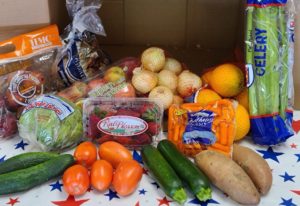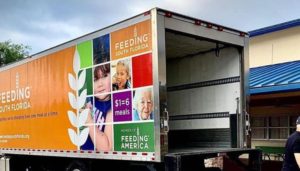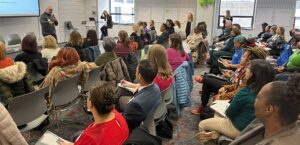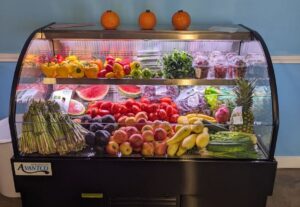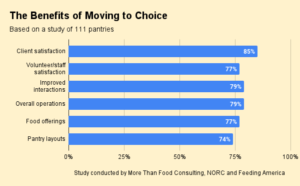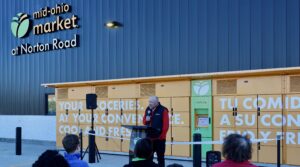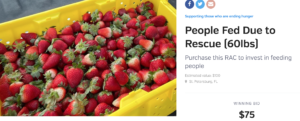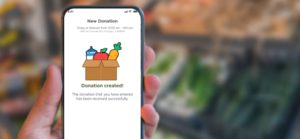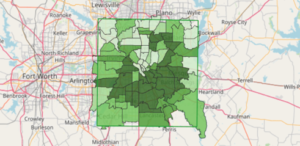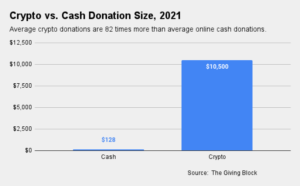Hotlines, text services and even navigation apps are among the tools food banks are using to better connect people to their neighborhood pantries during the pandemic.
The tools go beyond the basic pantry locators typically found on many websites, and often take advantage of the accessibility mobile technology offers. In some cases, as with telephone hotlines, the services do the double duty of providing emotional support to people going through a tough time.
With over 40 million jobless, the influx of first-time users to the charitable food system is without precedent. Feeding America reported that nearly 40% of those being served by the food banks in its network are new to food assistance.
While many are being served through the mass distributions that have grabbed media attention, food banks also continue to rely heavily on their traditional pantry networks to get food to people who need it. With the pandemic, helping newcomers navigate the vast pantry system has taken on greater urgency.
“They may not know that a pantry is three blocks down the road from them,” said Annie Andrews, Director of Supply Chain Operations at Feed More in Richmond, Va.
Feed More’s Hunger Hotline has seen referrals to its network of more than 270 pantries increase by 95% from January to April, and attributes this spike to many first-time callers out of work due to the pandemic. “We did have a number of folks within the service industry,” Andrews said.
To make securing food more seamless for the growing demand, Feed More is utilizing Link2Feed, a client-based software that records the family size, dietary restrictions and health requirements of their callers in a secured database that is shared with the food pantry they are referred to. This prevents clients from having to go through multiple intake processes and helps direct them to the best pantry for their needs, according to Andrews.

Text-based services are another way food banks are expanding their connectivity efforts through phones. Atlanta Community Food Bank recently launched its “Text For Help” function where people can text “findfood” for English or “comida” for Spanish and then their zip code to the food bank’s number. The user will receive a response text in the preferred language that includes a list of three pantries within a ten-mile radius.
Atlanta Community Food Bank realized the usefulness for such services during last year’s government shutdown when people who were unaccustomed to navigating the charitable food system were suddenly forced to figure it out. “We thought there’s got to be a way to make it easier,” said Kyle Waide, President and CEO. As Covid-19 began to spread, the food bank accelerated its plan to get a text-based service up and running, he said.
Combining pantry-finder tools with navigation apps offers a way to supercharge location services. WhyHunger, the New York City-based organization committed to ending food insecurity, partnered with the Waze app provider to upload its Find Food locator, a database of over 32,000 food providers, onto the navigation platform.
Waze, which incorporates user-submitted data for its GPS services and is popular for helping users find traffic and toll-free routes, has over 100 million monthly users. When Waze learned of WhyHunger’s pantry database, the company proposed to add it to its maps. “The news reports of seeing people in these unbelievably long lines, trying to get into soup kitchens and pantries for food, I think is kind of what sparked it for a lot of folks,” said Lorrie Clevenger, WhyHunger’s Director of U.S. Programs.
The pantry locator, along with WhyHunger’s other connection services, saw a 363% increase in user volume from January to April. Since the feature was integrated onto Waze, users have connected to about 30,000 WhyHunger Find Food locations across the United States.
To keep the Find Food database up to date for this demand, WhyHunger has a team of staff and volunteers regularly verifying the hours and locations of the pantries on its list. Most recently, WhyHunger worked with software engineers from 10xManagement, a tech talent agency, to enable the database to use crowdsourced information for updates in real time. “They were helping us figure out ways to get new information into the map, like all of the new COVID-specific sites that have been popping up,” Clevenger said.
The Find Food feature on the WhyHunger website has existed for over 10 years and includes more than half of the estimated 60,080 emergency food providers in the country. With this new capability, WhyHunger was able to add 1,000 additional providers to its database.

While these innovative tools are succeeding in streamlining the process of connecting people to pantries, the process isn’t always quick and easy.
Conversations on Capital Area Food Bank’s Hunger Lifeline, which serves Washington D.C. and parts of Virginia, can get emotional, as people who once donated to and volunteered at the food bank are now relying on it.
“For some people it’s really raw, and I have heard people crying on the phone,” said Sabrina Tadele, Manager of the Hunger Lifeline. “It’s very common for people to say, ‘I’m embarrassed, I wish I didn’t have to call, this is my first time doing this.’”
To better handle these calls, Capital Area Food Bank staff often provide further assistance by following up with clients about additional resources and providing information for other needs such as housing, which has become the second-most asked about service on the hotline.
Full-time call operator Denise Yates, who is contracted to Capital Area Food Bank through the National Caucus and Center of Black Aging, is oftentimes heard navigating callers to housing resources, drawing from her lifelong career experience in D.C. public housing.
One call from a mother who recently lost her job stands out for Tadele. The woman called because she didn’t know how to answer her two children when they asked if they’d have food to eat for dinner. Tadele immediately called her back to reassure her that the circumstances weren’t her fault.
“Sometimes you have to just hold it together and do your job, which is to give this person information,” Tadele said. “And sometimes it cuts through and it’s really hard to just make this about an information exchange. It’s very human.” — Feven Merid
Feven Merid is a freelance reporter and recent graduate of Columbia’s School of Journalism Master’s Program where she specialized in print and audio. Feven has previously been published in Documented, The Uptowner and Columbia University’s Library Podcasts.
CAPTION ABOVE: A volunteer taking calls at Feed More’s Hunger Hotline. Photo credit: Feed More
Like what you’re reading?



